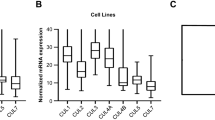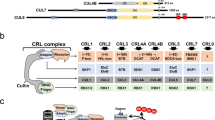Abstract
The ubiquitin ligase SCFMet30 is required for cell cycle progression in budding yeast. The critical function of SCFMet30 is inactivation of the transcriptional activator Met4. Here we show that a single ubiquitin chain is attached to Met4 through lysine at position 163. Inhibition of Met4 ubiquitination by mutating lysine to arginine at this position constitutively activates, but does not stabilize, Met4. This supports a proteolysis-independent role of Cdc34–SCFMet30-catalysed Met4 ubiquitination. Surprisingly, the ubiquitin chain attached to Met4 is linked through Lys 48 in ubiquitin, a ubiquitin chain structure that is usually required for substrate targeting to the 26S proteasome. These results suggest that Lys 48-linked ubiquitin chains can have a regulatory role independent of proteolysis.
This is a preview of subscription content, access via your institution
Access options
Subscribe to this journal
Receive 12 print issues and online access
$209.00 per year
only $17.42 per issue
Buy this article
- Purchase on Springer Link
- Instant access to full article PDF
Prices may be subject to local taxes which are calculated during checkout





Similar content being viewed by others
References
Hochstrasser, M. Ubiquitin-dependent protein degradation. Annu. Rev. Genet. 30, 405–439 (1996).
Hershko, A. & Ciechanover, A. The ubiquitin system. Annu. Rev. Biochem. 67, 425–479 (1998).
Schnell, J.D. & Hicke, L. Non-traditional functions of ubiquitin and ubiquitin-binding proteins. J. Biol. Chem. 278, 35857–35860 (2003).
Thrower, J.S., Hoffman, L., Rechsteiner, M. & Pickart, C.M. Recognition of the polyubiquitin proteolytic signal. EMBO J. 19, 94–102 (2000).
Spence, J. et al. Cell cycle-regulated modification of the ribosome by a variant multiubiquitin chain. Cell 102, 67–76 (2000).
Spence, J., Sadis, S., Haas, A.L. & Finley, D.A. Ubiquitin Mutant with Specific Defects in DNA repair and Multiubiquitination. Mol. Cell. Biol. 15, 1265–1273 (1995).
Hofmann, R.M. & Pickart, C.M. Noncanonical MMS2-encoded ubiquitin-conjugating enzyme functions in assembly of novel polyubiquitin chains for DNA repair. Cell 96, 645–653 (1999).
Hoege, C., Pfander, B., Moldovan, G.L., Pyrowolakis, G. & Jentsch, S. RAD6-dependent DNA repair is linked to modification of PCNA by ubiquitin and SUMO. Nature 419, 135–141 (2002).
Wang, C. et al. TAK1 is a ubiquitin-dependent kinase of MKK and IKK. Nature 412, 346–351 (2001).
Hicke, L. Protein regulation by monoubiquitin. Nature Rev. Mol. Cell Biol. 2, 195–201 (2001).
Kaiser, P., Flick, K., Wittenberg, C. & Reed, S.I. Regulation of transcription by ubiquitination without proteolysis: Cdc34/SCF(Met30)-mediated inactivation of the transcription factor Met4. Cell 102, 303–314 (2000).
Kuras, L. et al. Dual regulation of the met4 transcription factor by ubiquitin-dependent degradation and inhibition of promoter recruitment. Mol. Cell 10, 69–80 (2002).
Thomas, D., Jacquemin, I. & Surdin-Kerjan, Y. MET4, a leucine zipper protein, and centromere-binding factor 1 are both required for transcriptional activation of sulfur metabolism in Saccharomyces cerevisiae. Mol. Cell. Biol. 12, 1719–1727 (1992).
Thomas, D. & Surdin-Kerjan, Y. Metabolism of sulfur amino acids in Saccharomyces cerevisiae. Microbiol. Mol. Biol. Rev. 61, 503–532 (1997).
Patton, E.E. et al. SCF(Met30)-mediated control of the transcriptional activator Met4 is required for the G(1)–S transition. EMBO J. 19, 1613–1624 (2000).
MacCoss, M.J. et al. Shotgun identification of protein modifications from protein complexes and lens tissue. Proc. Natl Acad. Sci. USA 99, 7900–7905 (2002).
Rouillon, A., Barbey, R., Patton, E.E., Tyers, M. & Thomas, D. Feedback-regulated degradation of the transcriptional activator Met4 is triggered by the SCF(Met30)complex. EMBO J. 19, 282–294 (2000).
Skowyra, D., Craig, K.L., Tyers, M., Elledge, S.J. & Harper, J.W. F-Box Proteins are Receptors that Recruit Phosphorylated Substrates to the SCF Ubiquitin-Ligase Complex. Cell 91, 209–219 (1997).
Skowyra, D. et al. Reconstitution of G1 cyclin ubiquitination with complexes containing SCFGrr1 and Rbx1. Science 284, 662–665 (1999).
Kornitzer, D., Raboy, B., Kulka, R.G. & Fink, G.R. Regulated degradation of the transcription factor Gcn4. EMBO J. 13, 6021–6030 (1994).
Nakamura, S., Roth, J.A. & Mukhopadhyay, T. Multiple lysine mutations in the C-terminal domain of p53 interfere with MDM2-dependent protein degradation and ubiquitination. Mol. Cell. Biol. 20, 9391–9398 (2000).
Petroski, M.D. & Deshaies, R.J. Context of multiubiquitin chain attachment influences the rate of Sic1 degradation. Mol. Cell 11, 1435–1444 (2003).
Deffenbaugh, A.E. et al. Release of ubiquitin-charged Cdc34-S - Ub from the RING domain is essential for ubiquitination of the SCF(Cdc4)-bound substrate Sic1. Cell 114, 611–622 (2003).
Lee, C., Schwartz, M.P., Prakash, S., Iwakura, M. & Matouschek, A. ATP-dependent proteases degrade their substrates by processively unraveling them from the degradation signal. Mol. Cell 7, 627–637 (2001).
Verma, R. & Deshaies, R.J. A proteasome howdunit: the case of the missing signal. Cell 101, 341–344 (2000).
Elsasser, S. et al. Proteasome subunit Rpn1 binds ubiquitin-like protein domains. Nature Cell Biol. 4, 725–730 (2002).
Muratani, M. & Tansey, W.P. How the ubiquitin-proteasome system controls transcription. Nature Rev. Mol. Cell Biol. 4, 192–201 (2003).
Reed, S.I., Hadwiger, J.A. & Lorincz, A.T. Protein kinase activity associated with the product of the yeast cell division cycle gene CDC28. Proc. Natl Acad. Sci. USA 82, 4055–4059 (1985).
Guthrie, C. & Fink, G.R. Guide to Yeast Genetics and Molecular Biology (Academic Press, San Diego, 1991).
Cherest, H. & Surdin-Kerjan, Y. Genetic analysis of a new mutation conferring cysteine auxotrophy in Saccharomyces cerevisiae: updating of the sulfur metabolism pathway. Genetics 130, 51–58 (1992).
Peng, J. et al. A proteomics approach to understanding protein ubiquitination. Nature Biotechnol. 21, 921–926 (2003).
Gatlin, C.L., Kleemann, G.R., Hays, L.G., Link, A.J. & Yates, J.R., 3rd. Protein identification at the low femtomole level from silver-stained gels using a new fritless electrospray interface for liquid chromatography-microspray and nanospray mass spectrometry. Anal. Biochem. 263, 93–101 (1998).
Acknowledgements
We are grateful to D. Finley, D Thomas, M. Tyers and V. Yu for reagents and yeast strains. We thank S. Reed, C. Wittenberg, M. Nomura and R. Steele for comments on the manuscript and C. Greer for support in setting up the lab. We also thank H. Zhang and J. Yen for plasmid constructs. K.F. was supported by the Austrian Academy of Science (APART-fellowship). This work was supported by a grant from the National Institutes of Health to P.K.
Author information
Authors and Affiliations
Corresponding author
Ethics declarations
Competing interests
The authors declare no competing financial interests.
Supplementary information
Rights and permissions
About this article
Cite this article
Flick, K., Ouni, I., Wohlschlegel, J. et al. Proteolysis-independent regulation of the transcription factor Met4 by a single Lys 48-linked ubiquitin chain. Nat Cell Biol 6, 634–641 (2004). https://doi.org/10.1038/ncb1143
Received:
Accepted:
Published:
Issue Date:
DOI: https://doi.org/10.1038/ncb1143
This article is cited by
-
An expanded lexicon for the ubiquitin code
Nature Reviews Molecular Cell Biology (2023)
-
Bioinformatics and gene expression analysis of the legume F-box/WD40 proteins in NaCl and high temperature stress
Genetic Resources and Crop Evolution (2023)
-
Deubiquitinating enzymes and the proteasome regulate preferential sets of ubiquitin substrates
Nature Communications (2022)
-
CUL5-ARIH2 E3-E3 ubiquitin ligase structure reveals cullin-specific NEDD8 activation
Nature Chemical Biology (2021)
-
Molecular Biology of Cadmium Toxicity in Saccharomyces cerevisiae
Biological Trace Element Research (2021)



